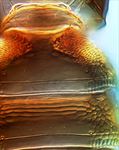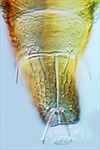Generic diagnosis
Female macropterous. Head wider than long, strongly reticulate, not projecting in front of eyes, ocellar region elevated; occipital ridge absent, cheeks constricted at base; maxillary palps 2-segmented. Antennae 8-segmented, segment I without paired dorso-apical setae; III with one simple sense cone, IV with two simple sense cones, one long and curved but one shorter and knobbed. Pronotum strongly reticulate, no long setae. Mesonotum reticulate, with median longitudinal division; anteromedian campaniform sensilla absent. Metanotum strongly reticulate medially with weak triangle, median setae close to posterior margin, campaniform sensilla present. Fore wing anterior margin fringe cilia longer than costa setae; first vein with wide gap in setal rows, two setae distally; second vein row of six setae; clavus with four veinal but no discal setae; posteromarginal fringe cilia wavy. Prosternal ferna divided; basantra membranous and without setae; mesosternal endofurca without spinula, metasternal endofurca lyre-shaped not reaching mesothorax. Legs strongly reticulate, tarsi 1-segmented. Tergites without ctenidia, with entire craspedum; tergite II anterolaterally with stout recurved microtrichia; III–VII strongly reticulate laterally, with transverse reticulation anteromedially, median campaniform sensilla close to posterior margin; VIII posterior margin without comb; IX without anterior campaniform sensilla; X median split complete, median setae with apex dilated. Sternites with entire craspedum, II–VII with three pairs posteromarginal setae, sternite VII with two small additional setae.
Male not known.
Biological data
Leaf-feeding, but with no specific host associations.
Distribution data
Widely distributed and recorded from Seychelles Islands, The Philippines, Pacific Islands, northern Australia, and southern China.
Nomenclatural data
Elixothrips Stannard & Mitri, 1962: 202. Type species Tryphactothrips brevisetis Bagnall 1921, by monotypy.
Only one species is placed in this genus (ThripsWiki, 2020), and this is recorded from southern China:
brevisetis (Bagnall, 1919: 257). (Tryphactothrips)
Relationship data
Thripidae sub-family Panchaetothripinae: this group is represented widely around the world, particularly in tropical areas, and comprises about 40 genera. Elixothrips shares with the members of the Astrothrips group the presence of a pair of areas of stout, recurved microtrichia anterolaterally on the second abdominal tergite (Mound et al., 2001). This genus is distinguished by the relatively trivial character state of a pair of capitate setae on the tenth abdominal tergite, but also by the mesonotum being fully divided longitudinally.
References
Mound LA, Marullo R & Trueman JWH (2001) The greenhouse thrips, Heliothrips haemorrhoidalis, and its generic relationships within the sub-family Panchaetothripinae (Thysanoptera; Thripidae). Journal of Insect Systematics and Evolution 32: 1–12.
Mound LA, Matsunaga J, Bushe B, Hoddle MS & Wells A (2017) Adventive Thysanoptera Species on the Hawaiian Islands: New Records and Putative Host Associations. Proceedings of the Hawaiian Entomological Society 49: 17-28.
ThripsWiki (2020) ThripsWiki - providing information on the World's thrips. <http://thrips.info/wiki/Main_Page>


